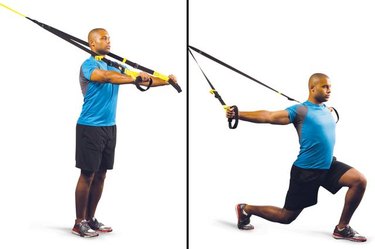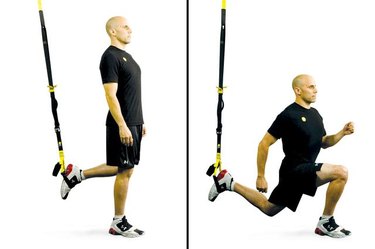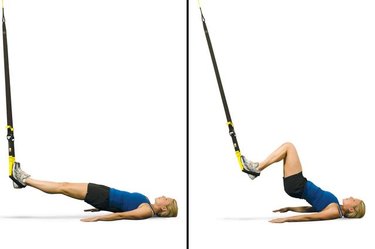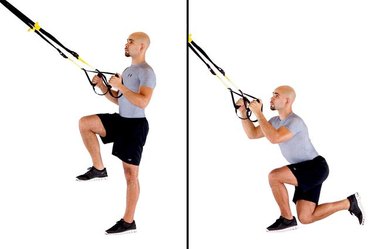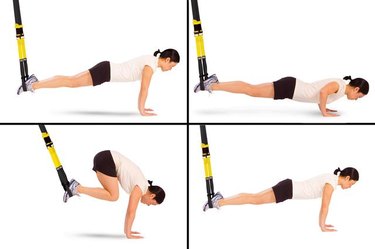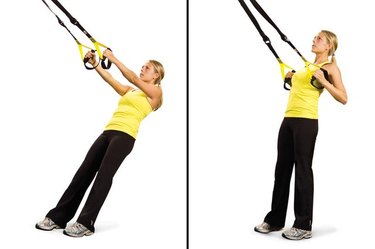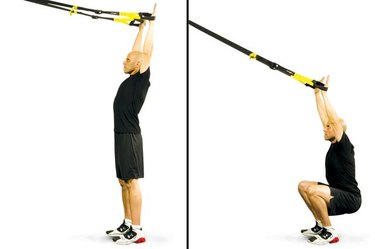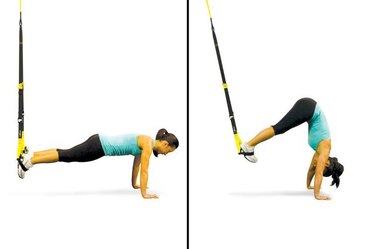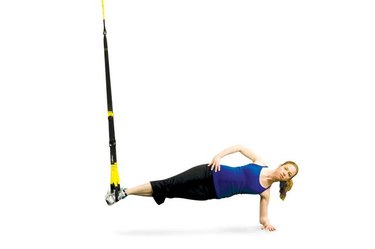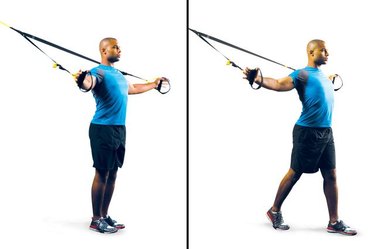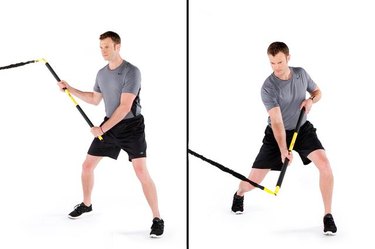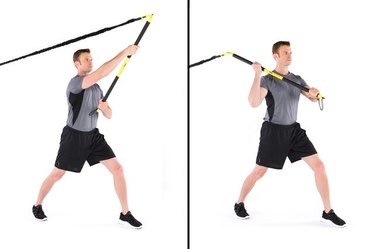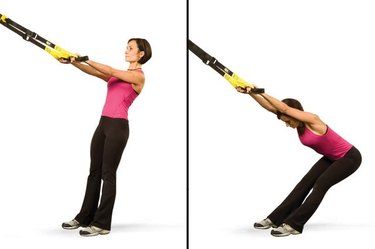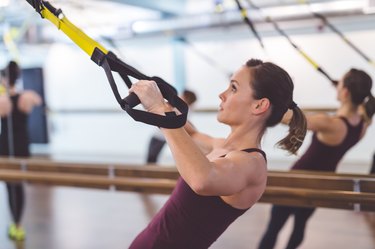
The TRX system (which was developed by a Navy SEAL so that he could train to stay in shape in small spaces with minimal equipment while deployed overseas) leverages gravity and body weight to build strength, endurance and balance while activating the core. TRX is great for building stability as well.
Whatever your fitness goals, this workout system can accommodate anyone from senior citizens with injuries to Olympic-level athletes, says Pete Holman, physical therapist and certified strength and conditioning specialist (CSCS) at TRX.
Video of the Day
Video of the Day
Plus, it's portable. The trademark black and yellow straps can be used in the gym, at home or even on the road. For best results, use an overhead anchor point that's seven to nine feet off the ground and strong enough to support your body weight. Always remember to weight-test your TRX system by pulling hard on it before using it for exercise.
1. Forward Lunge With T-Fly
Get off to a strong start with this lunge. "This helps with upper body stability and light core activation. It's a good way to get someone warmed up quickly," says Dan McDonogh, a TRX personal training specialist based in Portland, Oregon.
Keep light tension on the straps, by applying equal pressure. "To prevent lower back damage, make sure that your abs are engaged," says Holman.
- Adjust the straps to mid-length and stand facing away from the anchor, extend your arms at shoulder level with palms down.
- Take a long step forward and open your arms to a T position.
- Drive back up by pushing through front heel and pressing into the handles.
- Keep shoulder blades down. (It's not uncommon for people to shrug during this exercise, thereby compromising neck and shoulder muscles.)
2. Lunge
- With the strap at mid-calf, stand facing away from the anchor with your back foot suspended in both foot cradles below the anchor point.
- Lower into a lunge, keeping your torso tall with both knees at 90 degrees.
- Drive back up by pushing through your front heel.
Tip
“Be careful not to lunge forward," says Holman. “Instead move up and down.”
Read more: 22 New Lunges to Supercharge Leg Day
3. Hamstring Curl
This move really works the glutes, says McDonogh. "It's full-body integration for the hamstrings and butt." Also keep your head on the ground and your feet parallel, says Holman. "You want to avoid "sawing," so make sure the handles move up and down with equal pressure."
- Adjust the straps to mid-calf and sit on the floor facing the anchor point, place both heels in the foot cradles and roll onto your back.
- Lie down with your legs extended and feet directly below the anchor point.
- Lift your hips off the ground, drive both heels down and pull your heels toward your hips.
- Return to start.
4. Crossing Balance Lunge
"This lower body strengthening exercise is great for the glutes," says McDonogh. Slower is better with this exercise. And it actually makes it harder.
- Adjust the straps to mid-length and stand facing the anchor point, place your elbows under shoulders with palms facing each other, hands holding the straps.
- Center one leg to the anchor point then move the other back into a lunge crossing behind the working leg with your knee pointed toward the ankle.
- Drive back up by pushing through your front heel.
Read more: All of the Best Lower-Body Exercises
5. Atomic Push-Up With Crunch
"This is a fully integrated upper body core-challenging movement," says McDonogh. Everyone loves and hates this one at the same time. This is the one that humbles the guys." Be sure to lift your hips slightly before doing the crunch.
- Adjust the straps to mid-calf and kneel facing away from the anchor point with your feet in the foot cradles, place your hands on the ground slightly wider than shoulders width and lift up to a plank position.
- Lower your body toward the ground by bending your elbows to 90 degrees.
- Press back up, lift your hips slightly and crunch, bringing your knees to your chest.
Tip
Want a challenge? “When you do the push-up and crunch, pause at the end for three seconds,” says Holman. “You’ll feel it more. Each rep is the best rep of your life.”
6. TRX Low Row
Standing up to train has many benefits, says McDonogh. "This exercise works all the muscles in the back. It really helps with posture issues."
- Adjust the straps to a short height and stand facing the anchor point.
- Lean back with your arms straight with palms facing each other.
- Pull your body toward the anchor point and squeeze your shoulder blades.
- Return to start, maintaining the slight plank.
- Keep shoulders down. (It's a very common compensation for people to shrug here.)
Read more: 9 TRX Moves to Sculpt an Insanely Strong Upper Body
7. Overhead Squat
This move is a full-body mobility and stability exercise, says Holman. "It completely lights up the back side of the body and challenges the core."
- Adjust the straps to mid-length and stand facing the anchor point, place the back of your hands in the foot cradles with your arms extended overhead.
- Lower your hips toward the ground while driving your hands back and keeping your arms extended.
- Drive back up by pushing through the heels.
8. Pike
Holman calls this core stability exercise a "crunch on steroids." "Don't do this move too quickly or it can get sloppy," says Holman. Also, make sure you're driving your feet down with equal pressure.
- Adjust the straps to mid-calf and kneel facing away from the anchor point with both feet in the foot cradles and place your hands under your shoulders.
- Lift your knees off the ground into plank position and raise your hips up, keeping legs straight.
- Lower your body back to plank position.
9. Side Plank
Holman considers this one of the best core-stabilizing challenges. This works on stabilizing the spine and helps reduce the risk of injury to the back. "This works the love handles and helps get rid of a muffin top," says McDonogh.
- Adjust the strap to mid-calf and lie sideways to the anchor point.
- Place both feet in the foot cradles with your top leg slightly forward and place your elbow under your shoulder.
- Line up your front heel with your back toes, brace your core and lift your hips off the ground.
- Maintain your body alignment from head to toes. The elbow on the ground and both shoulders should be aligned as well.
10. Chest Stretch
"This is a great stretch through the shoulders, chest and abdomen," says McDonogh. Plus, it's good for shoulder stability.
- Adjust the strap to mid-length and stand facing away from the anchor point and place your arms out in 'T' position.
- Walk forward until you feel a light stretch across your chest and shoulders.
- Step forward to increase the stretch.
- Keep shoulder blades down.
11. Rip Squat Row
This move works the glutes, says Holman. "It's also great for back health and really strengthens the lower back."
- Adjust the straps to mid-length and stand facing the anchor point with your arms extended straight, gripping the bar with both hands.
- Lower your hips toward the ground, keeping your arms extended.
- Simultaneously stand up while pulling the bar to your chest and squeezing.
Read more: The Top 15 Moves to Tone Your Glutes
12. Rip Lunge Press
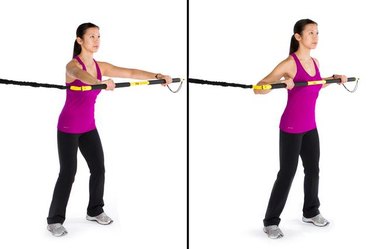
This is a very comprehensive total body move and a great balance exercise, says Holman. "Make sure your abs are engaged so your back doesn't arch," he says. "You don't want to put stress on your back. Your knee should stay in alignment with your foot."
- Adjust the straps to mid-length and stand facing away from the anchor point.
- Place the bar against your chest.
- Take a big step forward into a lunge position while extending the bar away from your chest.
- Return to start by pushing through your front heel while simultaneously bringing the bar to your chest.
13. Rip Paddleboard Row

"While executing this move, don't look in the direction you're rowing. Drop down like you're sitting on a chair," says Holman. This balance and postural exercise is great for paddle boarders, but it's also good for martial arts, golf and spine health.
- Adjust the straps to mid-length and stand facing the anchor point with the end of the bar extended toward the anchor point.
- Grip the bar with both hands like an oar.
- Lower your hips toward the ground while simultaneously striking the end of the bar past your foot.
- Return to the start by standing up and extending the bar back toward the anchor point with control.
14. Rip Hockey Slapshot
This dynamic exercise combines lunging and rotating movements. It's good for any sport where there's a high to low spiral pattern such as hockey, baseball, tennis or lacrosse, says Holman.
Bonus: it gets your heart rate up. "This can be done slower and more controlled or with some velocity for more of a challenge," says Holman. As with any new pattern, start out slow and work up in speed, he suggests.
- Adjust the strap to mid-length and stand sideways to the anchor point, with the end of the bar extended toward the anchor point.
- Grip the bar with both hands like a hockey stick.
- Pivot on the balls of your feet while simultaneously extending the bar at a low angle toward your front foot.
- Return to that start by pivoting on the balls of the feet with control.
15. Rip Overhead Axe Chop
This training move complements sports like tennis, volleyball or baseball with a lot of overhead movement that requires strength and stability. It works the triceps and shoulders and also aids balance and builds core strength, says Holman.
- Adjust the straps to mid-length and stand facing away from the anchor point in an offset foot stance with the bar over your shoulder.
- Grip the bar with both hands like an axe.
- Strike overhead at an upward angle.
- Return to start by lowering the bar back with control.
Tip
"Don’t push both arms out at the same time," Holman says. "Imagine you're going for a long cast with a fishing rod."
16. Lower Back Stretch
Watch your grip, says Holman. "Pretend your hands are like hooks. Don't white knuckle it. Let gravity do the work." If you spend your days sitting at a desk, this move can help give your back a break, says McDonogh. It's also a great finish to a workout.
- With the straps at mid-length, stand facing the anchor point with your feet hip-width apart.
- Gripping the bar, make sure your arms are straight and your palms are down.
- Lean back and drop your hips away from the anchor point.
- Place your head between your arms and relax your shoulders.
